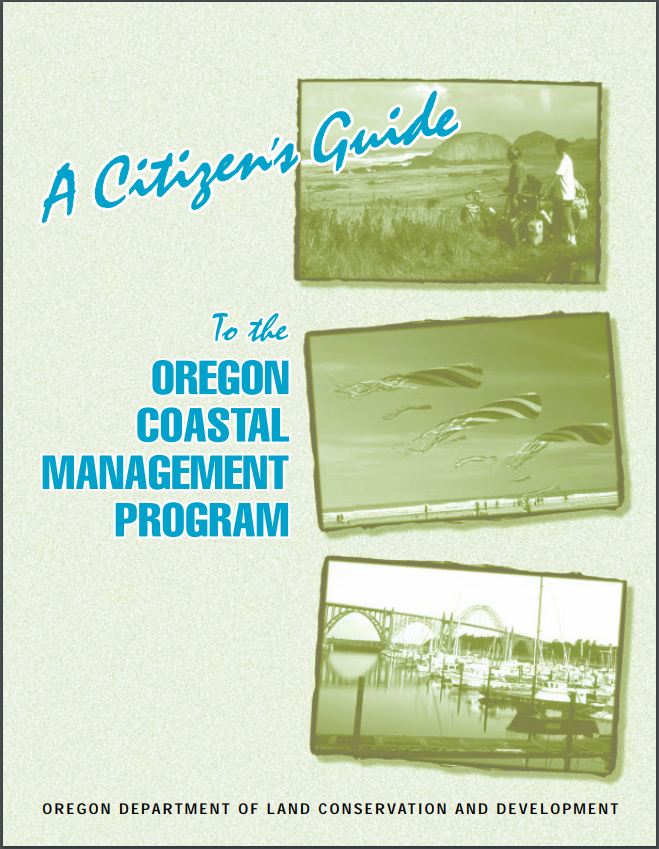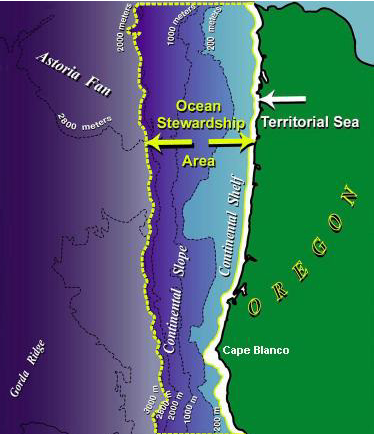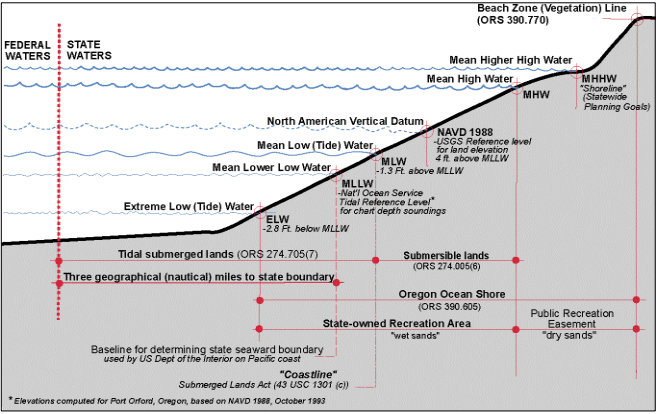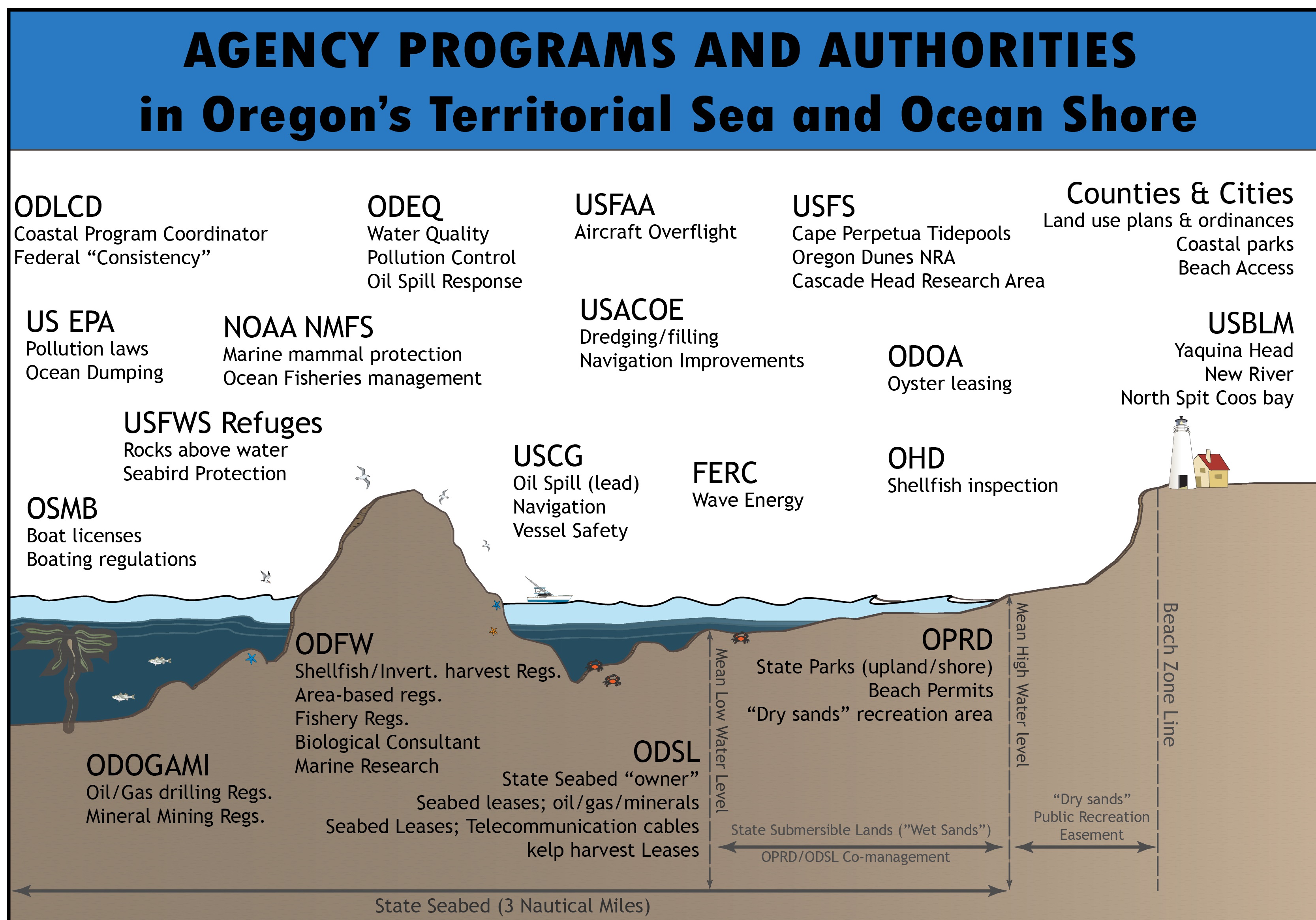
This page provides an explanation of how management of the Oregon Coastal Management Program functions, including the different agencies and their roles in reviewing and approving activities.
For a citizen's guide to the Oregon Coastal Management Program, visit this pdf link (1.99 MB) . (PDF)
Jurisdiction in Oregon
Areas of Authority at Sea
|
The state's ocean jurisdiction (the Territorial Sea) extends three nautical miles from shore (mean low water), although offshore rocks and islands can extend this area seaward, such as at Orford Reef near Cape Blanco (see map to right; Territorial Sea is shaded white). |
 |
Areas of Authority on Shore
Actual jurisdictional boundaries along the ocean shore are complicated because of two factors.
First, jurisdictional boundaries are almost always expressed in terms of the height of the water, or sea level. Sea level can vary with the slope of the shore, the height of the tide, storm events, and, over time, tectonic uplift or subduction of the continent or, sea level rise. So average water levels are reference, but these can change over time. In addition, land-based surveys historically began at a different base level than nautical or sea level surveys.
Second, different state and federal laws have been enacted that refer to different water levels to establish jurisdictional or regulatory boundaries. Different terminology between statutes can also lead to complications.
A large number of state and federal agencies have jurisdiction or regulatory authority in Oregon's Territorial Sea area. Click here for a pdf diagram (87 KB) in pdf format showing the general areas of concern for many of these agencies and programs. A list of acronyms is located in pdf Appendix C (3 KB) of the Oregon Territorial Sea Plan (pdf). For a description of terms used to describe shore boundaries and a diagram that shows the boundaries and terminologies in use along the Oregon Coast, see pdf Appendix D (76 KB) of the Oregon Territorial Sea Plan (pdf).
Legal Authorities in Oregon's Territorial Sea
| Oregon's Territorial Sea is the ribbon of ocean bordering the state reaching from the average low water line to 3 miles offshore. Numerous legal authorities apply to the management of ocean resources within this area, including state laws (e.g. ORS 196 and ORS 197), the Statewide Planning Goals (specifically Statewide Planning Goal 19: Ocean Resources), the Ocean Resources Management Plan, this Territorial Sea Plan, other Oregon statutes that provide specific management authority to state agencies, and state agency rules and coordination programs. Federal laws also apply in the Territorial Sea and are a part of the mix of legal authorities. The implementers of these "laws" include OPAC, state agencies, local government, and federal agencies. This section seeks to describe the linkage or relationship of these "laws" to each other. |
Oregon's Territorial Sea Plan
The Territorial Sea Plan (TSP) provides a coordinating vision for state and federal agencies that incorporates all of the above authorities, combined with ecosystem-based management objectives and prescribed management actions for specific areas within Oregon's coastal zone.
The 1991 Oregon Legislature amended ORS chapter 196 to establish the Ocean Policy Advisory Council made up of a variety of ocean stakeholders, local governments, and state agencies, and charged it with providing the Governor and state agencies with policy advice on ocean matters. The legislation gave the Department of Land Conservation and Development (DLCD), which includes the state’s federally-approved coastal management program, primary responsibility for ocean planning and providing assistance to OPAC. One of OPAC’s basic duties was to prepare a Territorial Sea Plan for managing the resources and activities in the state's territorial sea.
The purpose of the TSP is to facilitate intergovernmental coordination and promote common understanding of ecological goals and appropriate uses of ocean and coastal resources. The plan contains a combination of policy intentions (a goal and a set of policies and objectives), supported by scientific background information ocean and coastal areas and resources. The TSP relies on authorities and programs of state and federal agencies to carry out activities in the field.
Federal Consistency Requirements
What are the “enforceable policies” that would be used in the federal consistency review process?
"The term "enforceable policy" means State policies which are legally binding through constitutional provisions, laws, regulations, land use plans, ordinances, or judicial or administrative decisions, by which a State exerts control over private and public land and water uses and natural resources in the coastal zone." - 16 U.S.C. § 1456a. Coastal Zone Management Fund (Section 308)
Enforceable Policies are state policies that meet the definition of an enforceable policy under the CZMA and have been approved by NOAA for use in federal consistency reviews. The OCMP consists of a set of enforceable policies, including policies from Goal 19 Ocean Resources, the Territorial Sea Plan, and various other state agency authorities. These enforceable policies may be applied to federal actions that have reasonably foreseeable effects on resources of the coastal zone through the federal consistency provisions of the CZMA. Basically, the federal agency must provide a determination that their actions are consistent with the state’s enforceable policies.
Geographic Location Description

Status and Interests of Oregon Coast Native American Tribes
Applicable Federal Laws and Regulations
The following table lists the federal laws and regulations that apply to the ocean and coastal zone within Oregon's Territorial Sea.
|
Clean Water Act (33 USC 1251 - 1375) |
Under the Act, the US Environmental Protection Agency and the Oregon Department of Environmental Quality (DEQ) have an agreement that the DEQ regulates all point-source (e.g. a pipe) discharges into rivers, estuaries, and the ocean through the National Pollutant Discharge Elimination System (NPDES). Section 404 of the Act regulates the dumping of dredged materials and is administered by the US Army Corps of Engineers. |
|
Coastal Zone Management Act (16 USC 1451 - 1464), amended |
Established a national program of coastal management carried out by coastal states through state coastal-management programs reviewed and approved by the Secretary of Commerce through the National Oceanic and Atmospheric Administration (NOAA), Office of Ocean and Coastal Resources Management. State programs approved as meeting federal guidelines become the operative management program within the state's coastal boundary. The law, with subsequent amendments, requires all federal actions or programs affecting a state's coastal zone to be consistent with the mandatory provisions of that state's program. |
|
Comprehensive Environmental Response Compensation and Liability Act of 1980 (42 USC 9601 - 9657) |
This Act, known as CERCLA, provides the framework for responding to all manner of hazardous-waste contingencies, including spills, leaks, disposal, or discharges of oil, chemicals, or other hazardous substances into the environment. The Act also provides for recovery of damages from injury or loss of natural resources. The Act authorizes the President to enter into cooperative agreements with states to take actions under this Act, including damage assessment and recovery. |
|
Endangered Species Act of 1973 (16 USC 1531 - 1543) |
This Act authorized the Secretaries of the Interior and Commerce to list all species determined to be endangered or threatened. "Endangered species" means "any species which [that] is in danger of extinction throughout all or a significant portion of its range." "Threatened species" means "any species likely to become an endangered species within the foreseeable future throughout all or a significant portion of its range." The Act prohibits "take" (i.e. killing, harassing, hunting, etc.) and requires protective regulations and recovery plans for any listed species. The federal agencies may enter into agreements with states to develop and carry out conservation programs for such species. The Endangered Species Act refers to the commitments of the United States to various international agreements to conserve natural resources and wildlife. |
|
Fish and Wildlife Act of 1956 (16 USC 742a - 742j-2) |
Created the US Fish and Wildlife Service within the Department of the Interior and established legislative policy with regard to fish and wildlife resources. The duties and authorities of the US Fish and Wildlife Service are further described in other related laws such as the Fish and Wildlife Coordination Act (16 USC 661 - 666c) |
|
Magnuson Fisheries Conservation and Management Act (16 USC 1801 - 1882) and Magnuson–Stevens Fishery Conservation and Management Reauthorization Act of 2006 (PL 109-479) |
This Act is the legal framework for the United States to assert its management jurisdiction over fishery resources in the area from three to two hundred miles offshore. In addition to controlling the entry and activity of foreign fishing fleets, the Act created eight regional fishery-management areas, each governed by a council. States have representation on the Council. The Act generally preserves coastal state fisheries-management authority within the territorial sea unless a fishery within state waters is covered by a fishery management plan developed by the council or if the state's fishery program would, either by action or inaction, adversely affect a fishery in a fishery-management plan. Fishery-management plans must be approved by the Secretary of Commerce; implementation is through the National Marine Fisheries Service. |
|
Marine Mammal Protection Act (16 USC 1361 - 1407) |
This Act set up strict prohibitions against the taking, importation, or possession of marine mammals or marine-mammal products. "Take" is defined as "harass, hunt, capture, or kill, or attempt to harass, hunt, capture, or kill any marine mammal." Marine mammals include sea otters, polar bears, all cetaceans (whales), pinnipeds (seals and sea lions), and sirens (manatees and dugongs). Some "incidental take" is allowed in commercial-fishery operations. The act also created a Marine Mammal Commission and a Committee of Scientific Advisors on Marine Mammals. The US Fish and Wildlife Service (Department of the Interior) has jurisdiction over sea otters and polar bears; the National Marine Fisheries Service (Department of Commerce) has jurisdiction over all other marine mammals. |
|
Marine Plastics Pollution Research and Control Act of 1987 |
This Act implements an international agreement on ocean garbage titled Annex V of the Protocol of 1978 Relating to the International Convention for the Prevention of Pollution from Ships (known by word MARPOL). MARPOL is a primary impetus for ports in Oregon to provide garbage disposal and recycling facilities for vessels. |
|
Marine Protection, Research and Sanctuaries Act (16 USC 1431 - 1434) |
Title III of this act authorizes the Secretary of Commerce to designate marine areas that meet certain standards as National Marine Sanctuaries. The National Oceanic and Atmospheric Administration (NOAA) carries out the National Marine Sanctuary Program. There are no National Marine Sanctuaries off the Oregon coast, although the Heceta-Stonewall Banks complex at the outer edge of the Oregon continental margin has been identified as a potential sanctuary. There are five National Marine Sanctuaries on the Pacific Coast: the Olympic Coast NMS off the northern Washington coast, the Monterey Bay NMS in central California, the Gulf of the Farallones NMS and the adjacent Cordell Bank NMS off San Francisco Bay, and the Channel Islands NMS off southern California. A sanctuary can include state waters as well as federal. |
|
Migratory Bird Conservation Act of 1929 (16 USC 715 - 715r) |
This Act created a Migratory Bird Conservation Commission made up of the Secretaries of the Interior (chair), Agriculture, and Transportation; Congressional members; and ex-officio state members. The Commission approves the acquisition of land and water areas for sanctuaries, refuges, or other management purposes. |
|
Migratory Bird Treaty Act of 1918 (16 USC 703 - 712) as amended |
This landmark Act recognizes the importance of protecting migratory birds throughout their range and implements treaties with Canada (1916), Mexico (1936), Japan (1972), and the USSR (now Russia, in 1976) for protecting migratory birds. These treaties not only relate to hunting issues, but also to preservation of habitat on which birds depend. This Act is the basis for the Secretary of the Interior (through the U.S. Fish and Wildlife Service) to set and enforce hunting seasons and regulations for migratory birds on both public and private lands. |
|
National Environmental Policy Act (42 USC 4321-4347) |
Enacted in 1969 shortly after the first "Earth Day," this Act is the legal basis for requiring an Environmental Impact Statement for "major federal actions significantly affecting the quality of the human environment." The concept behind the law was one of a systematic and interdisciplinary approach to resource planning and decision making. |
|
National Wildlife Refuge System Administration Act of 1966 (16 USC 668dd - 668ee) as amended |
This Act created a National Wildlife Refuge System that includes wildlife refuges, wildlife ranges, wildlife management areas, and waterfowl production areas. The Secretary of the Interior (US Fish and Wildlife Service) is authorized to manage these areas and to permit uses that are compatible with the purposes of the established areas. This is the basic act authorizing the three National Wildlife Refuges in Oregon's territorial sea. |
|
Ocean Dumping Act (33 USC 1401 – 1445) |
Also known as Title I of the Marine Protection, Research, and Sanctuaries Act of 1972 (MPRSA), this act regulates ocean dumping of all types of materials, including dredged materials. The Act’s 1988 amendments aim to end the ocean dumping of sewage sludge and industrial waste in the ocean. The EPA and the Corps administer this Act while NOAA is charged with ongoing research and monitoring. |
|
Oil Pollution Act of 1990 |
Enacted in response to the Exxon Valdez oil spill, this act expands federal statutory liability for damages resulting from oil spilled or dumped into navigable waters. It also creates the Oil Spill Liability Trust Fund that may be used to compensate for injuries from spills. The Oil Pollution Act builds on CERCLA and CWA and contains many similar provisions. |
|
Rivers and Harbors Appropriation Act of 1899 |
This authorizes the US Army Corps of Engineers to permit, authorize, or construct piers, dikes, jetties, or other structures within navigable waters of the United States or to excavate or place fill material in these navigable waters. |
|
Submerged Lands Act (43 USC 1301 - 1315) |
This Act legislatively established state ownership of all lands and natural resources "beneath navigable waters" within the boundaries of the state, which are defined as a line three geographical miles from "the coastline" which is defined as the line of "ordinary low water." This "ordinary" (also "mean" or "average") low-water line is the same line as that which, in state law, de-marks "submersible" (intertidal) and "submerged" (subtidal). |
|
Wilderness Act of 1964 (16 USC 1131 - 1136) |
The Wilderness Act of 1964 directs the Secretary of the Interior to review all roadless areas of certain sizes, all islands within the National Wildlife Refuge System regardless of size, and to recommend to Congress areas to be designated for formal protection and preservation as wilderness. |
|
Laws Creating National Wildlife Refuge and Wilderness off Oregon 's Coast (Executive Orders 699, 5702, 7035, 7957, 2416; Public Land Order 4395 and 6287; Public Law 91-504 and 95-450) |
Establishes and/or amends designations related to the Three Arch Rocks Reservation, Goat Island Reservation, Cape Meares Migratory Bird Refuge, and the Oregon Islands National Wildlife Refuge. |
Applicable State Laws, Regulations, and Planning Goals
The State of Oregon holds the waters, shoreline, and living resources of its shoreline in trust for the public. The state has therefore established in law a program of planning and management that includes ocean resource goals and policies. The State has also instituted a number of laws related to ocean and coastal management, listed below.
Management of Oregon’s coastal zone are guided by Statewide Planning Goal 16: Estuarine Resources, Goal 17: Coastal Shorelands, Goal 18: Beaches and Dunes, and Goal 19: Ocean Resources. These goals provide the backbone for any specific management recommendations that may emerge from planning. More information on Oregon’s planning goals may be found at https://www.oregon.gov/lcd/OP/Pages/Goals.aspx.
|
Ocean Resources Management Act of 1987/1991 (ORS 196.405 et seq) |
This Act is the legislative and policy framework for Oregon's Ocean Program. Enacted in 1987, it resulted in the Oregon Ocean Resources Management Plan, 1990. Amended in 1991, the Act sets legislative policy for ocean resource management, creates the Ocean Policy Advisory Council in the Office of the Governor, and mandates a plan for the Territorial Sea as part of Oregon's Coastal Management Program. |
|
Statewide Land Use Planning (ORS 197.005 et seq) |
Enacted in 1973, this law establishes Oregon's statewide land-use planning program including the Land Conservation and Development Commission, the statewide planning goals as mandatory standards, listing areas to be addressed by the goals, including "...recreational and outstanding scenic areas"; "beaches, dunes, coastal headlands and related areas"; and "unique wildlife habitat." State agencies are required to "carry out their planning duties, powers, and responsibilities and take actions...with respect to programs affecting land use in compliance with (statewide planning) goals..." and to adopt a coordination program "to assure compliance with the goals..." |
|
Ocean Shores (Beach Bill) (ORS 390.605 et seq) |
Oregon's "ocean shore" is defined in ORS 390.605 as "land lying between extreme low tide of the Pacific Ocean and the line of vegetation as established and described by ORS 390.770. This shore area, whether publicly-owned or part of the privately-owned 23 miles, is declared to be a "state recreation area" under the jurisdiction of the Parks and Recreation Department for public recreational purposes. A complicating fact is that the part of this strip of land "between ordinary high tide and extreme low tide" is under concurrent jurisdiction of the State Land Board and the Parks and Recreation Department. The 1991 Oregon legislature required that this "ocean shore" area be addressed in the Territorial Sea Plan along with the submerged lands lying seaward to three miles. |
|
Submerged/Submersible Lands (ORS 274.005 et seq) |
Submerged lands are defined as "lands lying below the line of ordinary low water... within the boundaries of the state...". Submersible lands are defined as "lands lying between the line of ordinary high water and the line of ordinary low water of all navigable waters and all islands, shore lands...within the boundaries of this state...whether tidal or non-tidal." "Ordinary high and low water" means "annual mean high or mean low water of the preceding year." The Division of State Lands has "exclusive jurisdiction over all un-granted tidal submerged lands owned by the state" (ORS 274.710). "Un-granted" means that the bed or banks of the territorial sea have not been sold or otherwise conveyed out of public ownership. |
|
Fish and Wildlife Laws (ORS 496 et seq) |
These laws define "fish" and "wildlife," establish broad legislative policy regarding management of fish and wildlife, create and provide authority for the Department of Fish and Wildlife (ODFW) and its oversight Commission, and enact laws for threatened and endangered species. These laws give ODFW broad authority to develop fish and wildlife protection programs and perform actions necessary to carry out fish and wildlife laws. The ODFW has adopted general administrative rules about harvesting marine intertidal animals and has created "marine gardens" for certain intertidal areas where no taking of marine invertebrates is allowed. |
|
Commercial Fishing (ORS 506.001-.405) and Developmental Fisheries (ORS 506.450-.465) |
These statutes provide the Oregon Fish and Wildlife Commission with "exclusive jurisdiction over all fish, shellfish, and all other animals living intertidally on the bottom, within the waters of this state." Establishes food-fish management policy and creates authority for the commission to regulate commercial harvest of food fish. Establishes a developmental fisheries management program to plan the commercial development of underutilized food-fish species while protecting long-term sustainability of the commercial and biological values of those resources. |
|
Kelp Leasing (ORS 274.885 et seq) |
This law provides the Division of State Lands with exclusive jurisdiction over the state-owned tidal-submerged lands where kelp grows. Authorizes the Division to lease these lands "for the purpose of harvesting kelp and other seaweed after consultation with the State Fish and Wildlife Commission." There are some limitations on lease area, amount, and duration. |
|
Threatened or Endangered Wildlife Species (ORS 496.172 et seq) |
The Oregon Fish and Wildlife Commission is required to identify and establish programs to protect and conserve threatened and endangered wildlife species (ORS 496.172). Procedures and criteria are given for listing species under this law. |
|
Marine Water Quality (ORS 468) |
Discharge of pollutants into the waters of the state is prohibited. The term "waters of the state" is defined as including "the Pacific Ocean within the territorial limits of the State of Oregon." Numerous other provisions address controlling wastes, requiring certain practices, establishing effluent limitations and conditions, and setting water-quality standards generally. |
|
Oil Spill Contingency Planning (ORS 468B.300) |
This act requires an oil spill prevention and emergency response plan approved by the Department of Environmental Quality prior to the operation of onshore or offshore oil or gas facilities or operation of tanker, cargo, or passenger vessels in state waters of the Pacific Ocean, estuaries to the head of tide water, the Columbia River, and the Willamette River to Willamette Falls. This act includes legislative policy, provides the DEQ with authority to adopt standards for preparing contingency plans, and lists minimum requirements for such contingency plans. The act emphasizes coordination with the State of Washington and the United States Coast Guard, establishes an Oil Spill Prevention Fund, creates an Oregon coast safety committee, and establishes a wildlife rescue training program. |
International Law


